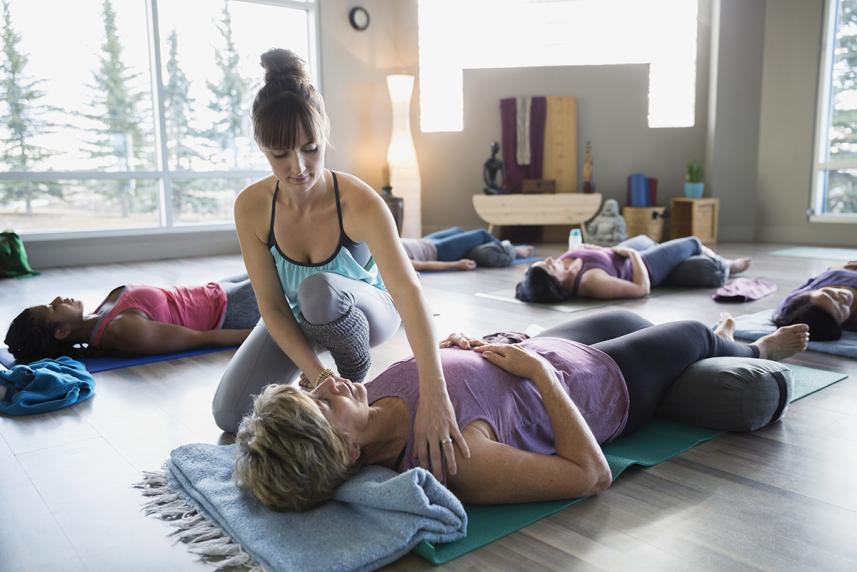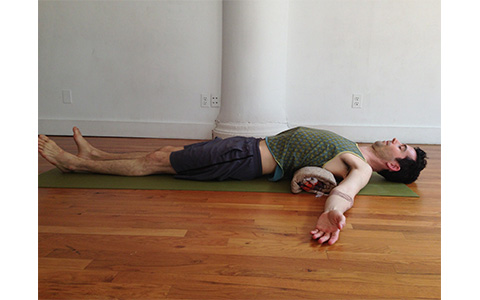Three restorative yoga poses to help you relax
Mellow out after a busy day with a little you-time.

Sometimes when you’re feeling overwhelmed, the best thing to do is find some quiet. It may sound intimidating to indulge in total silence, but it's a useful stress reliever. “Our minds are overbooked and over-sensationalized. We're constantly being confronted by ads, smells, and sounds,” says Abby Paloma, a New York City-based restorative yoga teacher and founder of Farm to Yoga. Give yourself a sensory break with restorative yoga. Unlike active yoga moves, restorative poses allow your body to relax in a supported way with props like blankets, letting your body “reset” itself.
“[Restorative yoga is] about removing all the things that pull us outside of ourselves, and asking us just to sit with who we are. It’s more than meditation, it’s an active relaxation,” Paloma says. The next time you need a break, steal away to do these thought-quieting poses, and return refreshed.
Supta Baddha Konasana
Say it: (SOOP-tah BAH-dah koh-NAH-sah-nah)
It’s an intricate name, but this pose is far from challenging. “It’s really accessible to all body types–men, women, post-natal moms, the elderly,” Paloma says. She often calls this popular reclining stretch “the goddess pose” or “the queen of restorative poses” because of its near-instant calming effect. “The hips are open, and the spine is fully supported. It’s immediately quieting to the nervous system and to the brain.”
Relax here:
Lay down, and use books, firm pillows or folded blankets to support your back at a 60-degree angle. Sit up against the pillows/blankets so that you’re fully supported at this angle. Draw the soles of your feet together so that your legs form a diamond shape. Place a rolled-up blanket or towel in a “U” shape over your feet and underneath the knees (with the curve of the “U” atop your feet). Rest your palms on rolled-up towels, blankets or cylindrical pillows. Close your eyes, gently drop your chin to your chest, and rest your mind inward for 10-15 minutes.
Handy Hint: While you do this pose, gently rub the flesh of your forehead up and down as if it were an “off switch,” Paloma says.
Restorative backbend
“Any time when your head is at a lower level than the heart, you can really start to relax in a different way,” Paloma says. “These poses are designed to have a very particular, rejuvenating affect on the nervous system–from the sympathetic to parasympathetic nervous systems,” which can kick into overload when we’re frazzled, she says. Plus, your arms open all the way up in this pose, allowing you to breathe deeply as you gently stretch out a tense back and neck.
Relax here:
Lay flat on the floor, and support the tips of your shoulder blades with a rolled-up blanket or towel. Open your arms into a “T” shape, palms facing upward. Close your eyes, and relax for 5-10 minutes.
Handy Hint: If you have lower back pain, bend your knees and place your feet flat on the floor.
Savasana
Say it: (shah-VAH-sah-nah)
“[This is] the ultimate relaxation pose of yoga in general,” Paloma says. “Savasana” literally translates to “corpse pose,” but don’t think of it in a morbid way. “The act of the pose is to absolutely do nothing, which can sometimes be rather difficult,” she says. There’s no need to focus on breathing technique or structure; this pose is designed so that you can really just rest in it.
Relax here:
Lay flat on the floor, and support the backs of your knees with a rolled-up blanket or towel. Support your head with a soft blanket or towel so your chin is gently tucked. Open your arms about 45-degrees away from your body, palms facing upward. Close your eyes, and spend 15-30 minutes in this pose.
Handy Hint: “It’s always really nice to support our heads and necks,” Paloma says. “We adapt all kinds of crazy head and neck habits over the years—whether you’re a dancer or on the computer often.”
Calm boost
“Restorative yoga is about finding quiet, dark, warm places that are calming to the [visceral] nervous system and, in turn, rejuvenating to the organs. Light, especially, is very stimulating, so you want to shut all the lights off,” Paloma says. Use a small scarf, eye pillow, or towel to cover your eyes and enhance the lights-off experience. The object’s weight on your forehead will alleviate racing thoughts, she says.
If you’re feeling a bit chilly, grab an extra blanket. “When you’re cold, you can’t relax, so it’s nice to have an additional blanket to keep warm,” she says. Want to set the mood with music? Choose soft, ambient sounds or nothing at all. “There are so little times in our lives that we get sheer silence,” Paloma says. “It’s important to learn how to just sit while being at ease.”


